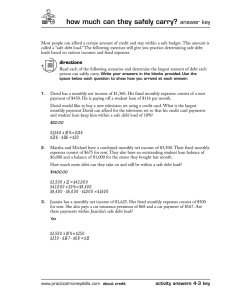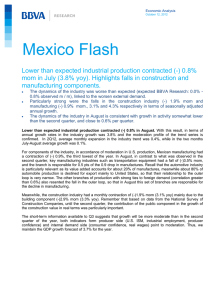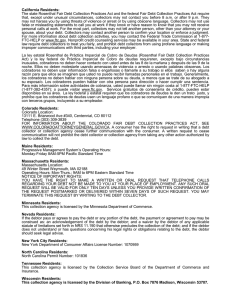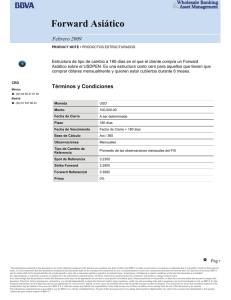MREL and TLAC : What are the consequences of
Anuncio
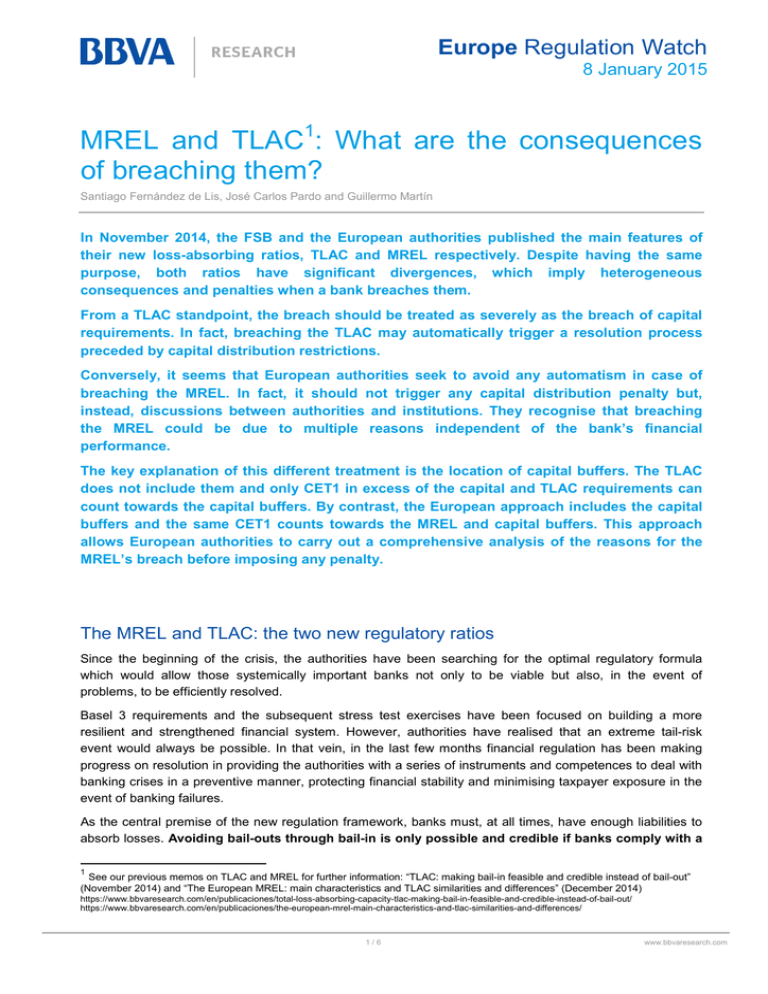
Europe Regulation Watch 8 January 2015 MREL and TLAC1: What are the consequences of breaching them? Santiago Fernández de Lis, José Carlos Pardo and Guillermo Martín In November 2014, the FSB and the European authorities published the main features of their new loss-absorbing ratios, TLAC and MREL respectively. Despite having the same purpose, both ratios have significant divergences, which imply heterogeneous consequences and penalties when a bank breaches them. From a TLAC standpoint, the breach should be treated as severely as the breach of capital requirements. In fact, breaching the TLAC may automatically trigger a resolution process preceded by capital distribution restrictions. Conversely, it seems that European authorities seek to avoid any automatism in case of breaching the MREL. In fact, it should not trigger any capital distribution penalty but, instead, discussions between authorities and institutions. They recognise that breaching the MREL could be due to multiple reasons independent of the bank’s financial performance. The key explanation of this different treatment is the location of capital buffers. The TLAC does not include them and only CET1 in excess of the capital and TLAC requirements can count towards the capital buffers. By contrast, the European approach includes the capital buffers and the same CET1 counts towards the MREL and capital buffers. This approach allows European authorities to carry out a comprehensive analysis of the reasons for the MREL’s breach before imposing any penalty. The MREL and TLAC: the two new regulatory ratios Since the beginning of the crisis, the authorities have been searching for the optimal regulatory formula which would allow those systemically important banks not only to be viable but also, in the event of problems, to be efficiently resolved. Basel 3 requirements and the subsequent stress test exercises have been focused on building a more resilient and strengthened financial system. However, authorities have realised that an extreme tail-risk event would always be possible. In that vein, in the last few months financial regulation has been making progress on resolution in providing the authorities with a series of instruments and competences to deal with banking crises in a preventive manner, protecting financial stability and minimising taxpayer exposure in the event of banking failures. As the central premise of the new regulation framework, banks must, at all times, have enough liabilities to absorb losses. Avoiding bail-outs through bail-in is only possible and credible if banks comply with a 1 See our previous memos on TLAC and MREL for further information: “TLAC: making bail-in feasible and credible instead of bail-out” (November 2014) and “The European MREL: main characteristics and TLAC similarities and differences” (December 2014) https://www.bbvaresearch.com/en/publicaciones/total-loss-absorbing-capacity-tlac-making-bail-in-feasible-and-credible-instead-of-bail-out/ https://www.bbvaresearch.com/en/publicaciones/the-european-mrel-main-characteristics-and-tlac-similarities-and-differences/ 1/6 www.bbvaresearch.com Europe Regulation Watch 8 January 2015 minimum requirement of liabilities with loss-absorbing capacity. In this regard, global and European policy makers have proposed two requirements: 2 • The Financial Stability Board (FSB) has proposed the Total Loss-Absorbing Capacity. • The European policy-makers, among others the European Banking Authority (EBA), have proposed the Minimum Requirement of Eligible Liabilities (MREL). 3 Despite being conceptually similar, both ratios have significant divergences. The purpose of this report is not to summarise the differences, but to analyse the different approaches adopted when answering the following question: What happens if an institution breaches the minimum requirement? Breaching the TLAC is equivalent to breaching the capital requirements Principle 10 of the FSB TLAC proposal states that “A breach or likely breach of minimum TLAC should be treated as severely as a breach or likely breach of minimum capital requirements”. That is to say, breaching the TLAC may trigger a resolution process and capital distribution would be restricted in advance. This requirement is consistent with the FSB’s TLAC approach, where the capital buffer is set “above” the minimum TLAC. In fact, only capital CET1 in excess of the capital and TLAC requirements can count towards the capital buffers. Therefore, if maturing TLAC debt is not renewed, a bank will breach its capital buffer first and will suffer capital distributions penalties as long as the capital buffer is eroded. We should recall that meeting the capital buffers is a requirement of the bank’s ability to distribute dividends to shareholders, bonuses to employees and coupons to the holders of AT1 debt. From the TLAC standpoint, whilst its introduction has challenged the foundations for senior debt, it may also be a burden for shareholders and AT1 investors. They must monitor the risk of cancelling dividends or nonpayment of the coupon due to the capital penalties linked to the automatic breach of capital buffers before breaching the minimum TLAC. As described below, the MREL does not seem to introduce any automatism and the link between breaching the MREL and capital penalties is blurred. Breaching the MREL does not necessarily imply entering into resolution and capital distribution restrictions Neither the BRRD nor the EBA consultation paper on MREL mentions anything about the implications of breaching the MREL. However, based on the MREL features proposed by the EBA, we may argue that European authorities would like to avoid any automatism in the event of breaching the minimum requirement. The main reason behind this argument is that the capital buffers, the so-called combined buffer in the CRD, are included in the criteria for determining the MREL, and not “above” the TLAC requirement as FSB 4 proposes. As the EBA proposes, the MREL is at least equal to the sum of two components: i) the loss absorption amount, and ii) the recapitalisation amount. When determining both elements, resolution authorities should include the capital buffer requirements with which each institution has to comply. 2 FSB (November 2014). Consultative document on “Adequacy of Loss-absorbing capacity of global systemically important banks in resolution”. 3 See appendix for further details. 4 EBA (December 2014). Consultation paper on criteria for determining the MREL, EBA/CP/2014/41. 2/6 www.bbvaresearch.com Europe Regulation Watch 8 January 2015 This approach rightly recognises that breaching the MREL may not necessarily be due to financial weaknesses in an institution but to a market systemic problem. As we describe below in case 4, a bank may be well capitalised and profitable, while being unable to issue debt instruments in the capital markets. Table 1 Breaching capital and / or MREL scenarios and penalties Case 1 Case 2 Case 3 Case 4 Case 5 Breaching the capital buffers? No Yes Yes No Yes Breaching the minimum capital requirements? No No Yes No Yes Breaching the MREL? No No No Yes Yes Develop a capital restoration plan - Yes Yes - Yes Develop a MREL restoration plan - - Yes Yes Yes Distribution restrictions - Yes Yes Case-by-case analysis Yes Triggering early intervention - Probably Yes Case-by-case analysis Yes Triggering resolution - . Yes - Yes Source: BBVA Research As Table 1 shows, breaching the MREL and capital minimum requirement has different implications depending on whether it occurs individually or simultaneously. • Case 1: The institution is in a going-concern condition and complies with MREL and capital requirements. • Case 2: If an institution suffers a CET1 shock but has a significant amount of long-dated eligible senior debt, it may breach the capital buffers (e.g. the CET1 is 6%) provided that it complies with MREL and minimum capital requirement (CET1 is over 4.5%). In this scenario, the bank would suffer capital distribution penalties on its maximum distributable amount. Moreover, the bank must present a capital conservation plan to the supervisor. Under exceptional circumstances, the supervisor may consider that the capital plan is not credible. In this scenario it would impose more stringent restrictions or, even, any early intervention measure defined 5 in the BRRD. • Case 3: This is an extension of Case 2. If the capital stock is significant and breaches the minimum capital requirement (e.g. CET1 is below the 4.5%), the institution enters into resolution. Thus, the bail-in eligible debt, which enabled compliance with the MREL prior to entering into resolution, would be used to recapitalise the failed institution. • Case 4: Breaching the MREL and not the capital ratios is the most challenging scenario. This scenario may occur when the institution cannot roll over its debts, while having a large amount of capital. The reasons underlying the closure of markets may be very different and authorities should carefully analyse them in order to decide whether or not to impose penalties. We can envisage three different crisis which may cause the MREL to be breached by an institution: o 5 A bank-idiosyncratic crisis. The bank cannot access the market due to perceived vulnerabilities and risks in its financial profile (e.g. two or more credit rating downgrades). This is particularly relevant when other peers do have access to the market. In this situation, it is highly probable that supervisors may impose capital distribution penalties to restore the See Bank Recovery and Resolution Directive (2014/59/EU) article 27. 3/6 www.bbvaresearch.com Europe Regulation Watch 8 January 2015 the bank’s financial health as an early intervention measure. Triggering a resolution process is only a last recourse option when early intervention measures fail. o A systemic crisis. As Figure 1 shows, the European 2012 crisis is a good example of a liquidity squeeze. Capital markets were almost closed for all banks, especially in certain countries, regardless of their financial strength, and markets did not discriminate between the banks in trouble and the rest. In this context, European banks issued a minimal amount of junior debt. In this scenario, a bank would not be able to roll over its debt regardless of its capital position and, therefore, would be at risk of breaching the MREL. Considering that a crisis and the closure of markets do not last forever, it is highly probable that those banks with higher capital levels would issue debt when market conditions ease. Figure 1 Issuance of junior debt by Eurozone banks (in EUR bn) 22 20 18 16 14 12 10 8 6 4 2 0 09Q1 09Q2 09Q3 09Q4 10Q1 10Q2 10Q3 10Q4 11Q1 11Q2 11Q3 11Q4 12Q1 12Q2 12Q3 12Q4 13Q1 13Q2 13Q3 13Q4 14Q1 14Q2 14Q3 Tier 1 Tier 2 Source: BBVA Research based on the ECB Financial Stability Review (November 2014) Against this backdrop, breaching the MREL in a systemic crisis should not automatically trigger any action, but should initiate discussions between authorities and the institution. An MREL restoration plan would be the first request before deciding any further measures. o An investor-idiosyncratic crisis. The limitation of the future investor base of the lossabsorbing debt (banks will be penalised if they invest in this debt) may have side-effects in terms of market appetite. If the investors’ base is narrowed, then the banks’ rollover capacity will decrease significantly and the whole banking sector would be proportionally affected. If the crisis hampers the investors’ capacity to buy MREL eligible debt, then banks would breach the MREL regardless of their financial performance. Thus, similarly to the previous scenario, authorities should request an MREL restoration plan before deciding any capital distribution penalty. • Case 5: This is the straightforward scenario when an institution suffers a significant capital shortfall. It breaches both requirements (the capital and MREL ratios) and, therefore, the institution enters into resolution. 4/6 www.bbvaresearch.com Europe Regulation Watch 8 January 2015 Appendix: MREL and TLAC – similarities and divergences As table 1 shows, the TLAC and the MREL definitions are not totally consistent in all their features. Table 1 Differences between MREL and TLAC requirement MREL Scope of covered firms Objective Eligible Instruments • • TLAC All credit institutions and investment firms Equity, junior debt, senior debt and other unsecured liabilities with residual maturity over one year. • Senior unsubordinated debt may be excluded if it accounts for less than 90% of the total liabilities in the same rank. Pillar 1 vs, Pillar • 2 approach Case-by-case approach (Pillar 2) based on each bank’s characteristics: resolvability assessment; complexity, risk profile, etc. • MREL is calculated based on the minimum capital, including capital buffers and leverage requirements and the recapitalisation needs after resolution. Denominator • Additionally, some adjustments may be applied based on risk profile, resolution strategy, etc. • MREL is expressed as a percentage of total liabilities and own funds of each institution. • However, the MREL’s quantum will be determined in monetary terms, based on several factors where the capital and leverage ratios play a central role. • MREL requirement is already approved and will come into force in 2016. • The EBA proposes a 48-month phase-in period (4 years) Come into force Global systemically important banks ( G-SIBS) To ensure that there is an appropriate level of loss-absorbing and recapitalisation capacity for the relevant group to be resolvable, and that the critical functions can be continued without taxpayer (public) funding and avoiding adverse effects on the financial system. • Sizing • 5/6 Comparability X Equity, junior debt, senior subordinated debt and part of the senior unsubordinated debt which is pari-passu with excluded liabilities (limited recognition up to 2.5% of RWA or higher if minimum TLAC requirement is above 16%). ≈ • All banks should have the same Pillar 1 minimum TLAC requirement plus a Pillar 2 firm-specific requirement. X • Pillar 1 standard minimum: max (16-20% ofRWA or 6% of leverage assets) plus Pillar 2 case-by-case requirements. • TLAC minimum requirement does not include capital buffers. • The TLAC is determined by the capital or leverage ratio • No earlier than 1 January 2019 • X www.bbvaresearch.com Europe Regulation Watch 8 January 2015 DISCLAIMER This document has been prepared by BBVA Research Department, it is provided for information purposes only and expresses data, opinions or estimations regarding the date of issue of the report, prepared by BBVA or obtained from or based on sources we consider to be reliable, and have not been independently verified by BBVA. Therefore, BBVA offers no warranty, either express or implicit, regarding its accuracy, integrity or correctness. Estimations this document may contain have been undertaken according to generally accepted methodologies and should be considered as forecasts or projections. Results obtained in the past, either positive or negative, are no guarantee of future performance. This document and its contents are subject to changes without prior notice depending on variables such as the economic context or market fluctuations. BBVA is not responsible for updating these contents or for giving notice of such changes. BBVA accepts no liability for any loss, direct or indirect, that may result from the use of this document or its contents. This document and its contents do not constitute an offer, invitation or solicitation to purchase, divest or enter into any interest in financial assets or instruments. Neither shall this document nor its contents form the basis of any contract, commitment or decision of any kind. In regard to investment in financial assets related to economic variables this document may cover, readers should be aware that under no circumstances should they base their investment decisions in the information contained in this document. Those persons or entities offering investment products to these potential investors are legally required to provide the information needed for them to take an appropriate investment decision. The content of this document is protected by intellectual property laws. It is forbidden its reproduction, transformation, distribution, public communication, making available, extraction, reuse, forwarding or use of any nature by any means or process, except in cases where it is legally permitted or expressly authorized by BBVA. 6/6 www.bbvaresearch.com
